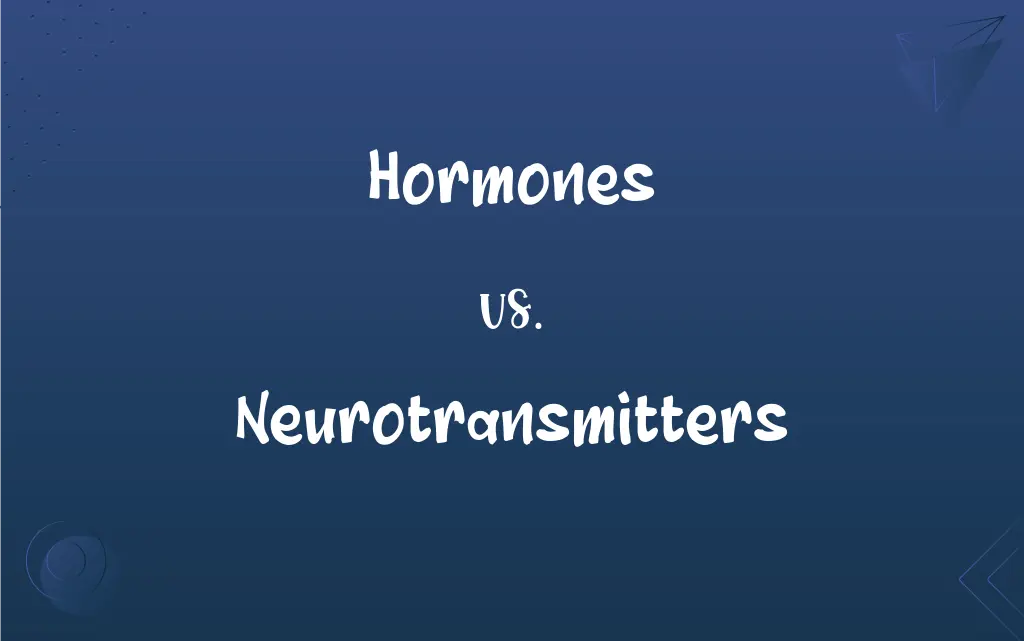Hormones vs. Neurotransmitters: What's the Difference?
Edited by Aimie Carlson || By Harlon Moss || Updated on October 28, 2023
Hormones are chemical messengers released by glands that regulate distant organs, while neurotransmitters are chemicals facilitating nerve cell communication.

Key Differences
Hormones are chemical substances produced by endocrine glands, such as the thyroid or pancreas. These substances travel through the bloodstream to act on specific target organs. Neurotransmitters, on the other hand, are chemicals released by nerve cells (neurons) to transmit signals to neighboring neurons, muscles, or glands.
Hormones can exert their effects over longer durations and at locations distant from their site of release. In contrast, neurotransmitters act more locally, primarily influencing processes in the immediate vicinity of their release within the synaptic cleft between neurons.
The release of hormones is typically in response to various stimuli, including changes in the environment or internal conditions. Neurotransmitters, however, are often released in response to electrical signals within the nervous system.
Examples of hormones include insulin, which regulates blood sugar, and adrenaline, which prepares the body for a 'fight or flight' response. Neurotransmitters include substances like serotonin, which can influence mood, and acetylcholine, which plays a role in muscle activation.
Both hormones and neurotransmitters play vital roles in maintaining homeostasis and enabling the body's response to internal and external changes. However, their mechanisms of action, release, and functional areas are distinct.
ADVERTISEMENT
Comparison Chart
Producing Organs
Produced by endocrine glands.
Produced by neurons (nerve cells).
Mode of Transmission
Travel through the bloodstream.
Transmitted across synapses between neurons.
Duration of Action
Can have long-lasting effects.
Typically have quick and localized effects.
Response Trigger
Released in response to various stimuli.
Released in response to electrical signals.
Examples
Insulin, adrenaline.
Serotonin, acetylcholine.
ADVERTISEMENT
Hormones and Neurotransmitters Definitions
Hormones
Hormones are chemical messengers that travel through the bloodstream to deliver signals to distant organs.
When blood sugar rises, the pancreas releases insulin, a hormone that helps cells absorb glucose.
Neurotransmitters
Neurotransmitters can either excite or inhibit neighboring nerve cells.
GABA is a neurotransmitter that generally inhibits signals between neurons.
Hormones
Hormones are regulatory substances released in an organism to stimulate specific cells or tissues into action.
The thyroid gland produces hormones that regulate metabolism.
Neurotransmitters
Neurotransmitters bridge the gap between nerve cells, enabling rapid communication.
Norepinephrine is a neurotransmitter involved in alertness and the body's stress response.
Hormones
Hormones are products of endocrine glands that influence physiological activities.
Cortisol is a hormone that's involved in the body's stress response.
Neurotransmitters
Neurotransmitters facilitate communication within the nervous system.
The neurotransmitter dopamine plays a role in reward and pleasure systems in the brain.
Hormones
Hormones can alter cell activity in response to environmental or internal changes.
The hormone melatonin regulates sleep patterns in response to light and dark cycles.
Neurotransmitters
Neurotransmitters are chemicals that transmit signals from one neuron to another across synapses.
Serotonin is a neurotransmitter often linked to feelings of well-being and happiness.
Hormones
Hormones coordinate and regulate various functions from growth to metabolism.
Growth hormone plays a crucial role in determining height and body structure.
Neurotransmitters
Neurotransmitters play roles in various functions from mood regulation to muscle movement.
Acetylcholine is a neurotransmitter essential for muscle contraction.
Hormones
A substance, usually a peptide or steroid, produced by one tissue and conveyed by the bloodstream to another to effect physiological activity, such as growth or metabolism.
Neurotransmitters
A chemical substance, such as acetylcholine or dopamine, that transmits nerve impulses across a synapse.
Hormones
A synthetic compound that acts like a hormone in the body.
Neurotransmitters
Plural of neurotransmitter
Hormones
Any of various similar substances found in plants and insects that regulate development.
Hormones
Hormone replacement therapy.
If the doctor gives the OK, I should be able to start hormones by the end of the month.
Hormones
Plural of hormone
FAQs
How do neurotransmitters function?
Neurotransmitters transmit signals between neurons across synapses.
Where are neurotransmitters stored?
Neurotransmitters are stored in vesicles within neuron endings.
Are all hormones proteins?
No, while many hormones are proteins, others are steroids or amines.
How do drugs affect neurotransmitters?
Many drugs can increase, decrease, or modify neurotransmitter action, influencing mood or behavior.
Can neurotransmitters be measured?
Yes, but measuring neurotransmitter levels directly in the brain is challenging. However, certain tests can measure levels in blood or cerebrospinal fluid.
How are hormones released?
Hormones are released into the bloodstream in response to specific stimuli.
Do imbalances in neurotransmitters cause mental disorders?
Imbalances can contribute to certain mental disorders, though it's often a complex interplay of factors.
What's the difference between hormones and neurotransmitter receptors?
While both bind to specific molecules, hormone receptors often reside on or in target cells, whereas neurotransmitter receptors are typically on neuron membranes.
What are hormones?
Hormones are chemical messengers produced by endocrine glands that regulate specific target organs.
Can hormones act on the brain?
Yes, certain hormones can influence brain function and behavior.
Are hormones only found in humans?
No, hormones are found in all multicellular organisms, from plants to animals.
How do neurons produce neurotransmitters?
Neurons synthesize neurotransmitters using specific enzymes and precursor molecules.
Can one molecule be both a hormone and a neurotransmitter?
Yes, certain molecules, like norepinephrine, can function as both.
How does the body regulate neurotransmitter levels?
Neurotransmitter levels are regulated by synthesis, release, reuptake, and degradation mechanisms.
Why is understanding hormones and neurotransmitters important?
Understanding them is vital for insights into numerous physiological processes, from metabolism to cognition, and for medical and therapeutic interventions.
What regulates hormone levels?
Hormone levels are typically regulated by feedback mechanisms in the body.
How are hormones and neurotransmitters related?
While both are chemical messengers, hormones act on distant targets via the bloodstream, while neurotransmitters act locally in synapses.
How do diseases affect hormones?
Certain diseases can disrupt hormone production, release, or action, leading to various symptoms.
Do neurotransmitters only act in the brain?
No, neurotransmitters also function outside the brain, such as in neuromuscular junctions.
Can neurotransmitters affect mood?
Yes, certain neurotransmitters like serotonin and dopamine play key roles in mood regulation.
About Author
Written by
Harlon MossHarlon is a seasoned quality moderator and accomplished content writer for Difference Wiki. An alumnus of the prestigious University of California, he earned his degree in Computer Science. Leveraging his academic background, Harlon brings a meticulous and informed perspective to his work, ensuring content accuracy and excellence.
Edited by
Aimie CarlsonAimie Carlson, holding a master's degree in English literature, is a fervent English language enthusiast. She lends her writing talents to Difference Wiki, a prominent website that specializes in comparisons, offering readers insightful analyses that both captivate and inform.































































